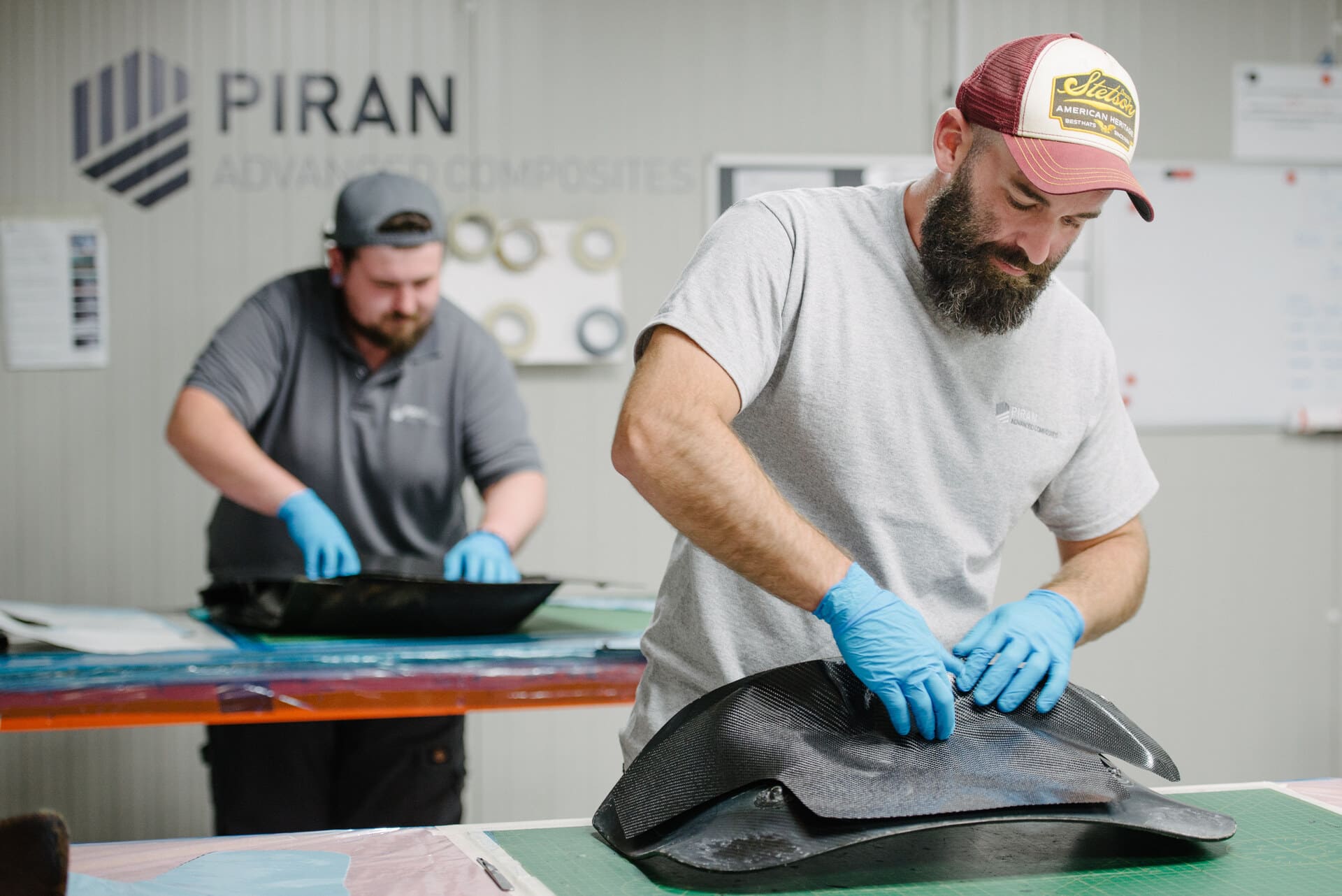Composite tooling has many advantages in multiple industries. In this post, we will explore what a composite tool is and how it is made. At Piran Composites, we design, engineer, and manufacture small and large-scale tools and specialise in tooling solutions for optimal efficiency.
So, let’s first clarify – what is a composite tool?
Table of Contents
Definition – What Is a Composite Tool?
A composite tool is a mould made from composite materials. This mould, also known as a tool, is then used to shape further composite materials into new product components. Composite tooling is used in advanced manufacturing to create precise, durable, and lightweight components.
How are Composite Tools Made?
Composite tools are made by designing and manufacturing a mould that shapes composite materials into desired components. This typically starts with creating a plug/pattern of the final part, from which the tooling mould is developed.
![What is Composite Tooling [Materials, Moulds & Method] 1 two men working by hand on composite materials](https://pirancomposites.com/wp-content/uploads/145-Piran-advanced-composites-1-1024x684.jpg)
The Plug/Pattern
A plug/pattern mirrors the exact shape and dimensions of the outside of the final product. The plug usually features flanges, which are the border sections that allow handling, alignment, or attachment during the manufacturing process. In simple terms, the plug is the shape of the final part with borders.
The Mould
After the plug has been created, the next step is forming the mould. The mould is laminated over the plug to create a cavity of the desired shape. This cavity is filled with mould release agents, then resin and fibre reinforcements to form the composite component. Once the resin has filled the mould, the component undergoes the curing process.
Male & Female Moulds
A male mould is a convex form in which the composite material is applied over its surface. Whereas a female mould is a concave form in which the material is laid inside it. Male moulds can be more cost-effective, especially when building large-scale, one-off moulds, although they do require extra work to carry out finishing techniques on the outside of the component. Female moulds typically don’t need this finishing step, as they provide a smooth external surface due to the materials being pressed against the mould’s inner surface.
Composite Tooling Materials
Composite tooling materials include metal alloys, steel, silicone, rubber and fibreglass, plus polymers such as silicone and urethane. Metal alloys may be used for durability and high-temperature applications, whereas silicone and rubber may be chosen for more flexible moulds. Epoxy and polyurethane tooling boards may also be used to create durable master moulds. Ultimately, the tooling materials used depend on the tooling design and specific needs of the product.
![What is Composite Tooling [Materials, Moulds & Method] 2 Member of the Piran team in cap and grey t-shirt working on a purple sheet material](https://pirancomposites.com/wp-content/uploads/007-Piran-advanced-composites-1-1024x684.jpg)
Mould Release Agents
Mould release agents are the final step in the composite tool manufacturing process. These agents are applied to the surface of the mould and create a barrier that prevents the composite material/resins from sticking to the mould. This gives a clean finish on the surface of the manufactured component during the demoulding process. It also extends tool life, allowing it to be reused for more production cycles.
The Advantages of Composite Tools in Various Industries
Composite tools create components with precise dimensional accuracy and a smooth surface finish. This is useful in applications that need precision components with aerodynamic properties, such as in the aerospace, automotive, and renewable energy industries.
Aerospace and Aviation
Composite tooling in aerospace enables the production of components that are lighter, stronger and more durable than those made from traditional materials. This enhances fuel efficiency, increases service life and reduces maintenance costs. It also allows for the creation of complex shapes, opening new possibilities in aircraft design and performance.
![What is Composite Tooling [Materials, Moulds & Method] 3 Staff at work on the floor in St. Issey premises of Cornwall business, Piran Advanced Composites is a concept engineering company working in marine and repairs](https://pirancomposites.com/wp-content/uploads/070-Piran-advanced-composites-1024x684.jpg)
Automotive Industry
Similarly, composite tooling enables the production of strong, lightweight components in the automotive industry. This leads to better fuel efficiency and performance. Also, the durability and corrosion resistance of composites extend the lifespan of automotive parts.
Renewable Energy and Beyond
In the renewable energy industry, composite tooling enables the production of large, lightweight, and durable components such as wind turbine blades. These materials offer excellent fatigue resistance and the ability to withstand harsh environmental conditions. This supports long-term efficiency and reliability in renewable energy generation. Composite tooling also allows for innovative designs that can capture energy more efficiently, contributing to the industry’s goal of sustainable and cost-effective energy solutions.
![What is Composite Tooling [Materials, Moulds & Method] 4 Two members of the Piran team working at worktops all arranged neatly in the Clean Room.](https://pirancomposites.com/wp-content/uploads/137-Piran-advanced-composites-1.jpg)
Innovations in Composite Tooling Technologies
Recent advancements in composite tooling are opening up a world of possibilities when it comes to manufacturing high-performance parts. Here is a list of technologies that are currently shaping the composite tooling world.
- Advancements in 3D printing technologies – creating complex geometries for tools.
- Tooling materials – the development of more temperature-resistant materials.
- Smart technologies – being used for real-time monitoring of the tooling process.
- Powder bed processes – in which fine layers of metal powder are melted with a laser to form layers of the component.
- Additively manufactured composite tooling – producing lighter, more energy-efficient tooling.
Breakthrough Materials and Manufacturing Processes
Recent breakthroughs include the evolution of large-format additive manufacturing (LFAM) systems such as the BAAM (Big Area Additive Manufacturing) and CEAD printers. These printers have enhanced capabilities, such as the ability to print at different angles and produce large tooling components with efficiency and reduced waste. These systems also use thermoplastic pellets, which are cost-effective and do not require post-processing in autoclaves/ovens.
Another development includes autoclave moulding for aerospace, in which Airtech’s Print-Tech platform and Dahltram tooling resins have made strides. These technologies enable the rapid production of high-accuracy moulds that can withstand the high temperatures and pressures of autoclave processing.
Composite Tooling Solutions – Innovation, Design, and Manufacture
Here at Piran Composites, we provide robust, high-temperature composite tooling solutions and design, engineer, and manufacture high-precision composite components. We work on small and large-scale projects, bringing years of industry experience and expertise to the process. Unlike other providers, we handle every step of the design and manufacturing process and support you in bringing your project to life from start to finish.
![What is Composite Tooling [Materials, Moulds & Method] 5 The CMS Machine at work](https://pirancomposites.com/wp-content/uploads/025-Piran-advanced-composites-684x1024.jpg)
Conclusion – Why CompositeTooling Is Key to Advancing Manufacturing
Composite tooling enables the manufacture of precise, lightweight, and durable components. These tools are often in the form of moulds, which can be male or female and are produced from an initial plug or pattern. Various materials are used in the composite tooling process, and mould release agents ensure a smooth finish on the surface of the component.
Recent advancements such as large-format additive manufacturing (LFAM) and high-performance tooling resins are driving the rapid production of high-accuracy moulds. When combined with other high-performance processes, such as large-scale five-axis machining, the production of composite components is limitless.
Do you need an expertly-tailored composite mould or component?
Contact our expert team to learn how we design and manufacture precision tools, moulds, and composite components for your every need.
![What is Composite Tooling [Materials, Moulds & Method] 6 The team outside Cornwall business, Piran Advanced Composites at the Aerohub Businesss park premises](https://pirancomposites.com/wp-content/uploads/172-Piran-advanced-composites-1024x684.jpg)

